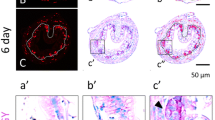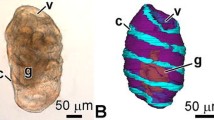Summary
We have developed an organ culture system of the anuran small intestine to reproduce in vitro the transition from larval to adult epithelial form which occurs during spontaneous metamorphosis. Tubular fragments isolated from the small intestine ofXenopus laevis tadpoles were slit open and placed on membrane filters in culture dishes. In 60% Leibovitz 15 medium supplemented with 10% charcoal-treated serum, the explants were maintained in good condition for at least 10 days without any morphologic changes. Addition of triiodothyronine (T3) at a concentration higher than 10−9 M to the medium could induce cell death of larval epithelial cells, but T3 alone was not sufficient for proliferation and differentiation of adult epithelial cells. When insulin (5 µg/ml) and cortisol (0.5 µg/ml) besides T3 were added, the adult cells proliferated and differentiated just as during spontaneous metamorphosis. On Day 5 of cultivation, the adult cells rapidly proliferated to form typical islets, whereas the larval ones rapidly degenerated. At the same time, the connective tissue beneath the epithelium suddenly increased in cell density. These changes correspond to those occurring at the onset of metamorphic climax. By Day 10, the adult cells differentiated into a simple columnar epithelium which possessed the brush border and showed the adult-type lectin-binding pattern. Therefore, the larval epithelium of the small intestine responded to the hormones and transformed into the adult one. This organ culture system may be useful for clarifying the mechanism of the epithelial transition from larval to adult type during metamorphosis.
Similar content being viewed by others
References
Bonneville, M. A. Fine structural changes in the intestinal epithelium of the bullfrog during metamorphosis. J. Cell Biol. 18:579–597; 1963.
Bonneville, M. A.; Weinstock, M. Brush border development in the intestinal absorptive cells ofXenopus during metamorphosis. J. Cell Biol. 44:151–171; 1970.
Dodd, M. H. I.; Dodd, J. M. The biology of metamorphosis. In: Lofts, B., ed. Physiology of amphibia, vol. 3. New York: Academic Press; 1976:467–599.
El Maraghi-Ater, H.; Mesnard, J.; Hourdry, J. Hormonal control of the intestinal brush border enzyme activities in developing anuran amphibians. I. Effects of hydrocortisone and insulin during spontaneous metamorphosis. Gen. Comp. Endocrinol. 61:53–63; 1986.
Enami, J.; Enami, S.; Koga, M. Growth of normal and neoplastic mouse mammary epithelial cells in primary culture: stimulation by conditioned medium from mouse mammary fibroblasts. Gann 74:845–853; 1983.
Fox, H. Amphibian metamorphosis. Clifton, New Jersey: Humana Press; 1983:119–126.
Fox, H.; Bailey, E.; Mahoney. R. Aspects of the ultrastructure of the alimentary canal and respiratory ducts inXenopus laevis larvae. J. Morphol. 138:387–406; 1972.
Goldstein, I. J.; Hayes, C. E. The lectins: carbohydrate-binding proteins of plants and animals. Adv. Carbohydr. Chem. Biochem. 35:127–340; 1978.
Hourdry, J.; Dauca, M. Cytological and cytochemical changes in the intestinal epithelium during anuran metamorphosis. Int. Rev. Cytol. [Suppl.]5:337–385; 1977.
Hsu, S. Y.; Yu, N. W.; Chen, S. J. Development of Δ5-3β-hydroxysteroid dehydrogenase activity in the interrenal gland ofRana catesbeiana. Gen. Comp. Endocrinol. 42:167–170: 1980.
Hulsebus, J.; Farrar, E. S. Insulin-like immunoreactivity in serum and pancreas of metamorphosing tadpoles. Gen. Comp. Endocrinol. 58:114–119; 1985.
Ishizuya-Oka, A.; Shimozawa, A. Development of the connective tissue in the digestive tract of the larval and metamorphosingXenopus laevis. Anat. Anz. 164:81–93; 1987.
Ishizuya-Oka, A.; Shimozawa, A. Ultrastructural changes in the intestinal connective tissue ofXenopus laevis during metamorphosis. J. Morphol. 193:13–22; 1987.
Ishizuya-Oka, A.; Shimozawa, A. Changes in lectin-binding pattern in the digestive tract ofXenopus laevis during metamorphosis. II. Small intestine. J. Morphol. 205:9–15; 1990.
Krug, E. C.; Honn, K. V.; Battista, J., et al. Corticosteroids in serumRana catesbeiana during development and metamorphosis. Gen. Comp. Endocrinol. 52:232–241; 1983.
Leloup, J.; Buscaglia, M. La triiodothyronine, hormone de la métamorphose des Amphibiens. C.R. Hebd. Seances Acad. Sci. Ser. D 284:2261–2263; 1977.
McAvoy, J. W.; Dixon, K. E. Cell proliferation and renewal in the small intestinal epithelium of metamorphosing and adultXenopus laevis. J. Exp. Zool. 202:129–138; 1977.
Nieuwkoop, P. D.; Faber, J. Normal table ofXenopus laevis (Daudin). Amsterdam: North-Holland Publishers; 1967.
Nishikawa, A.; Yoshizato, K. Hormonal regulation of growth and life span of bullfrog tadpole tail epidermal cells cultured in vitro. J. Exp. Zool. 237:221–230; 1986.
Pouyet, J. C.; Hourdry, J. Effet de la thyroxine sur la structure des épithéliocytes intestinaux en culture organotypique, chez la larve deDiscoglossus pictus Otth (Amphibien Anoure). Biol. Cell. 29:123–134; 1977.
Pouyet, J. C.; Hourdry, J. Effet de la thyroxine sur la prolifération des épithéliocytes intestinaux en culture organotypique, chez la larve du Crapaud-accoucheur (Alytes obstetricans Laurenti). Biol. Cell. 38:237–242; 1980.
Pouyet, J. C.; Hourdry, J. In vitro study of the intestinal brush border enzyme activities in developing anuran amphibian: effects of thyroxine, cortisol, and insulin. J. Exp. Zool. 245:200–205; 1988.
Rheinwald, J. G.; Green, H. Serial cultivation of strains of human epidermal keratinocytes: the formation of keratinizing colonies from single cells. Cell 6:331–344; 1975.
Simnett, J.; Balls, M. Cell proliferation inXenopus tissues: a comparison of mitotic incidence in vivo and in organ culture. J. Morphol. 127:363–372; 1969.
Trowell, O. A. The culture of mature organs in a synthetic medium. Exp. Cell Res. 16:118–148; 1959.
Yoshizato, K. Biochemistry and cell biology of amphibian metamorphosis with a special emphasis on the mechanism of removal of larval organs. Int. Rev. Cytol. 19:97–149; 1989.
Yoshizato, K.; Kikuyama, S.; Shioya, N. Stimulation of glucose utilization and lactate production in cultured human fibroblasts by thyroid hormone. Biochim. Biophys. Acta. 627:23–29; 1980.
Author information
Authors and Affiliations
Rights and permissions
About this article
Cite this article
Ishizuya-Oka, A., Shimozawa, A. Induction of metamorphosis by thyroid hormone in anuran small intestine cultured organotypically in vitro. In Vitro Cell Dev Biol - Animal 27, 853–857 (1991). https://doi.org/10.1007/BF02630987
Received:
Accepted:
Issue Date:
DOI: https://doi.org/10.1007/BF02630987




